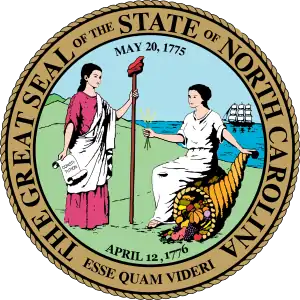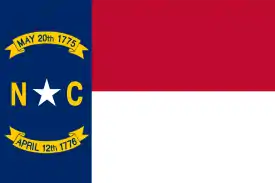Asheville, North Carolina
Asheville is a city in, and the county seat of, Buncombe County, North Carolina, United States.[7] Located at the confluence of the French Broad and Swannanoa rivers, it is the largest city in Western North Carolina, and the state's 12th-most populous city. According to 2019 estimates, the city's population was 92,870, up from 83,393 in the 2010 census.[8] It is the principal city in the four-county Asheville metropolitan area, which had a population of 424,858 in 2010, and an estimate population in 2019 of 462,680.[9]
Asheville, North Carolina | |
|---|---|
| City of Asheville | |
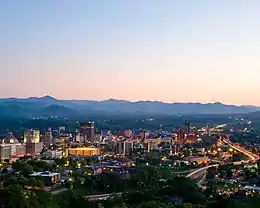     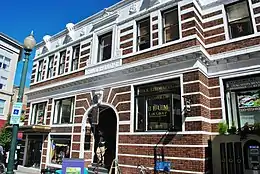 Downtown Asheville and surrounding area | |
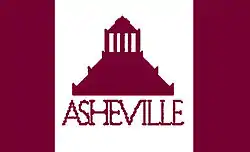 Flag  Seal | |
| Nickname(s): "Land of the Sky"[1] | |
| Motto(s): "Quality of Service, Quality of Life" | |
 Location in Buncombe County and the state of North Carolina | |
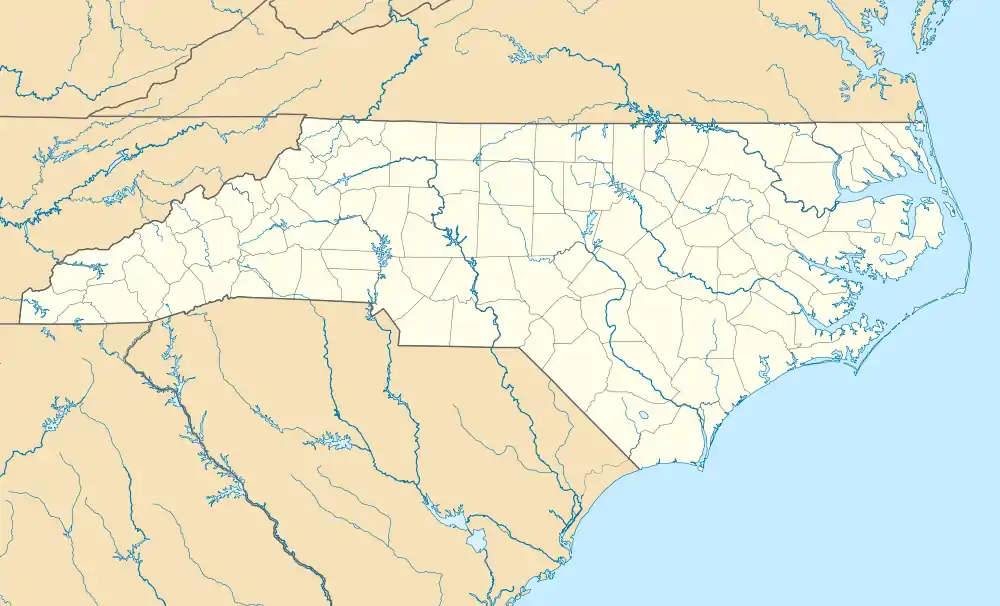 Asheville Location in North Carolina  Asheville Location in the United States | |
| Coordinates: 35°35′45″N 82°33′10″W | |
| Country | United States |
| State | North Carolina |
| County | Buncombe |
| Incorporated | 1797 |
| Named for | Governor Samuel Ashe |
| Government | |
| • Mayor | Esther Manheimer |
| • Council Members | Brian Haynes, Vijay Kapoor, Julie Mayfield, Sheneika Smith, Gwen Wisler, Keith Young |
| Area | |
| • City | 45.95 sq mi (119.01 km2) |
| • Land | 45.57 sq mi (118.01 km2) |
| • Water | 0.39 sq mi (1.00 km2) 0.66% |
| Elevation | 2,134 ft (650 m) |
| Population | |
| • City | 83,393 |
| • Estimate (2019)[4] | 92,870 |
| • Density | 2,038.14/sq mi (786.94/km2) |
| • Urban | 238,318 |
| • Metro | 424,858 |
| • Demonym | Ashevillan |
| US Census Bureau official | |
| Time zone | UTC−5 (Eastern) |
| • Summer (DST) | UTC−4 (EDT) |
| ZIP Codes | 28801–28806, 28810, 28813–28816 |
| Area code(s) | 828 |
| FIPS code | 37-02140[5] |
| GNIS feature ID | 1018864[6] |
| Website | www |
History
Origins
Before the arrival of the Europeans, the land where Asheville now exists lay within the boundaries of the Cherokee Nation, which had homelands in modern western North and South Carolina, southeastern Tennessee, and northeastern Georgia.[10] A town at the site of the river confluence was recorded as Guaxule by Spanish explorer Hernando de Soto during his 1540 expedition through this area.[11][12] His expedition comprised the first European visitors,[11] who carried endemic Eurasian infectious diseases that killed many in the native population.[13]
The Cherokee had traditionally used the area by the confluence for open hunting and meeting grounds. They called it Untokiasdiyi (in Cherokee), meaning "Where they race", until the middle of the 19th century.[14][15]
European Americans began to settle in the area of Asheville in 1784, after the United States gained independence in the American Revolutionary War. In that year, Colonel Samuel Davidson and his family settled in the Swannanoa Valley, redeeming a soldier's land grant from the state of North Carolina made in lieu of pay. Soon after building a log cabin at the bank of Christian Creek, Davidson was lured into the woods and killed by a band of Cherokee hunters resisting white encroachment. Davidson's wife, child, and female slave fled on foot overnight to Davidson's Fort (named after Davidson's father General John Davidson) 16 miles away.
In response to the killing, Davidson's twin brother Major William Davidson and brother-in-law Colonel Daniel Smith formed an expedition to retrieve Samuel Davidson's body and avenge his murder. Months after the expedition, Major Davidson and other members of his extended family returned to the area and settled at the mouth of Bee Tree Creek.[16]
The United States Census of 1790 counted 1,000 residents of the area, excluding the Cherokee Native Americans as a separate nation. Buncombe County was officially formed in 1792. In the 1800 US Census, some 107 settlers in the county were slaveholders, owning a total of 300 enslaved African Americans. Total county population was 5,812.[17]
The county seat, named "Morristown" in 1793, was established on a plateau where two old Indian trails crossed. In 1797, Morristown was incorporated and renamed "Asheville" after North Carolina Governor Samuel Ashe.[18][19]
In the 1800s, James McDowell established land for burial of slaves belonging to his and the Smith families in Asheville. His son William Wallace McDowell continued this practice, setting aside about two acres of land for this purpose.
Civil War

On the eve of the Civil War, James W. Patton, son of an Irish immigrant, was the largest slaveholder in the county, and had built a luxurious mansion, known as The Henrietta, in Asheville.[17] Buncombe County had the largest number of prominent slaveholders in Western North Carolina, many in the professional class based in Asheville, numbering a total of 293 countywide in 1863.[17]
Asheville, with a population of about 2,500 by 1861, remained relatively untouched by battles of the Civil War. The city contributed a number of companies to the Confederate States Army, as well as a number for the Union Army. For a time, an Enfield rifle manufacturing facility was located in the town.
The war did not reach Asheville until early April 1865, when the "Battle of Asheville" was fought at the present-day site of the University of North Carolina at Asheville. Union forces withdrew to Tennessee, which they had occupied since 1862. They had encountered resistance in Asheville from a small group of Confederate senior and junior reserves, and recuperating Confederate soldiers in prepared trench lines across the Buncombe Turnpike. The Union force had been ordered to take Asheville only if they could accomplish it without significant losses.
An engagement was fought later that month at Swannanoa Gap, as part of the larger Stoneman's Raid throughout western North Carolina, Virginia and Tennessee. Union forces retreated in the face of resistance from Brig. Gen. Martin, commander of Confederate troops in western North Carolina. Later, Union forces returned to the area via Howard's Gap and Henderson County. In late April 1865, North Carolina Union troops from the 3rd North Carolina Mounted Infantry, under the overall command of Union Gen. George Stoneman, captured Asheville.[20] After a negotiated departure, the 2,700 troops left town, accompanied by "hundreds of freed slaves."[17]
The slave George Avery was among 40 slaves known to have traveled with the troops to Tennessee. There he enlisted in the US Colored Troops. He returned to Asheville after being formally discharged in 1866. After the war, he was hired by his former master William W. McDowell to manage the South Asheville Cemetery, a public place for black burials. This is the oldest and largest black public cemetery in the state. By 1943, when the last burial was conducted, it held remains of an estimated 2,000 people.
Later, the federal troops returned and plundered Asheville, burning a number of Confederate supporters' homes in Asheville.[21]
1880s
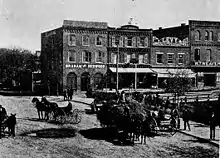
On October 2, 1880, the Western North Carolina Railroad completed its line from Salisbury to Asheville, the first rail line to reach the city. Almost immediately it was sold and resold to the Richmond and Danville Railroad Company, becoming part of the Southern Railway in 1894.[22] With the completion of the first railway, Asheville developed with steady growth as industrial plants increased in number and size, and new residents built homes.[23] Textile mills were built to process cotton from the region, and other plants were set up to manufacture wood and mica products, foodstuffs, and other commodities.[24]
The 21-mile (34 km) distance between Hendersonville and Asheville of the former Asheville and Spartanburg Railroad was completed in 1886.[25] By that point, the line was operated as part of the Richmond and Danville Railroad until 1894 and controlled by the Southern Railway afterward.[26] Following major changes in the industry because of the competition from automobiles, railroad restructuring resulted in Asheville's final passenger train, a coach-only remnant of the Southern Railway's Carolina Special, making its last run on December 5, 1968.
Asheville had the first electric street railway lines in the state of North Carolina, the first of which opened in 1889. These were replaced by buses in 1934.[27]
1900s to present
.jpg.webp)
.jpg.webp)
In 1900, Asheville was the third-largest city in the state, behind Wilmington and Charlotte.[28] Asheville prospered in the decades of the 1910s and 1920s. During these years, Rutherford P. Hayes, son of President Rutherford B. Hayes, bought land, and worked with the prominent African-American businessman Edward W. Pearson, Sr. to develop his land for residential housing known as the African-American Burton Street Community.[29] Hayes also worked to establish a sanitary district in West Asheville, which became an incorporated town in 1913, and merged with Asheville in 1917.[30]
The Asheville Masonic Temple was constructed in 1913, under the direction of famed architect Richard Sharp Smith, a Freemason. It was the meeting place for local Masons through much of the 20th century.[31]
The Great Depression hit Asheville quite hard. On November 20, 1930, eight local banks failed.[32] Only Wachovia remained open with infusions of cash from Winston-Salem. Because of the explosive growth of the previous decades, the per capita debt owed by the city (through municipal bonds) was the highest in the nation.[33] By 1929, both the city and Buncombe County had incurred over $56 million in bonded debt to pay for a wide range of municipal and infrastructure improvements, including City Hall, the water system, Beaucatcher Tunnel, and Asheville High School. Rather than default, the city paid those debts over a period of fifty years.[34]
From the start of the depression through the 1980s, economic growth in Asheville was slow. During this time of financial stagnation, most of the buildings in the downtown district remained unaltered. As a result, Asheville has one of the most impressive, comprehensive collections of Art Deco architecture in the United States.[35][36]
On July 15–16, 1916, the Asheville area was subject to severe flooding from the remnants of a tropical storm which caused more than $3 million in damage. Areas flooded included part of the Biltmore Estate, and the company that ran it sold some of the property to lower their maintenance costs. This area was later developed as an independent jurisdiction known as Biltmore Forest, which is now one of the wealthiest in the country.
In September 2004, remnants of Hurricanes Frances and Ivan caused major flooding in Asheville, particularly at Biltmore Village.[37][38]
From the 1950s to the 1970s, urban renewal displaced much of Asheville's African-American population.[39] Asheville's neighborhoods of Montford and Kenilworth, now mostly white, used to have a majority of black home owners.[40] Since the late 20th century, there has been an effort to maintain and preserve the South Asheville Cemetery, in the Kenilworth neighborhood. It is the largest public black cemetery in the state, holding about 2000 burials, dating from the early 1800s and slavery years, to 1943. Fewer than 100 of the graves are marked by tombstones.
In 2003, Centennial Olympic Park bomber Eric Robert Rudolph was transported to Asheville from Murphy, North Carolina, for arraignment in federal court.[41][42]
In July 2020, Asheville City Council voted to provide reparations to Black residents for the city's "historic role in slavery, discrimination and denial of basic liberties". The resolution was unanimously passed, and Asheville committed to "make investments in areas where Black residents face disparities".[43] Also in 2020, efforts were made to remove or change several monuments in the city that celebrated the Confederate States of America or slave owners. Attorney Sean Devereux proposed renaming Asheville in honor of Arthur Ashe, whose ancestors were owned by Samuel Ashe, for whom the city was named.[44][45]
Geography
Asheville is located in the Blue Ridge Mountains at the confluence of the Swannanoa River and the French Broad River. According to the United States Census Bureau, the city has a total area of 45.3 square miles (117.2 km2), of which 44.9 square miles (116.4 km2) is land and 0.31 square miles (0.8 km2), or 0.66%, is water.
Climate
Asheville has a humid subtropical climate (Köppen Cfa), resembling the rest of the Piedmont region of the southeastern U.S., but with noticeably cooler temperatures due to the higher elevation; it is part of USDA Hardiness zone 7a.[46] The area's summers in particular, though warm, are not as hot as summers in cities farther east in the state, as the July daily average temperature is 73.8 °F (23.2 °C) and there is an average of only 9.4 afternoons with 90 °F (32.2 °C)+ highs annually;[lower-alpha 1] The last time a calendar year passed without a 90 °F (32.2 °C) reading was 2009. Moreover, warm mornings where the low remains at or above 70 °F or 21.1 °C are much less common than 90 °F or 32.2 °C afternoons. Winters are cool, with a January daily average of 37.1 °F (2.8 °C) and highs remaining at or below freezing on 5.5 afternoons.[47]
Official record temperatures range from −16 °F (−26.7 °C) on January 21, 1985 to 100 °F (37.8 °C) on August 21, 1983;[48] the record cold daily maximum is 4 °F or −15.6 °C on February 4, 1895, while, conversely, the record warm daily minimum is 77 °F or 25 °C on July 17, 1887.[47] Readings as low as 0 °F (−17.8 °C) or as high as 95 °F (35 °C) rarely occur, the last occurrences being January 7, 2014 and July 1, 2012, respectively.[47] The average window for freezing temperatures is October 17 to April 18, allowing a growing season of 181 days.[47]
Precipitation is relatively well spread, though the summer months are slightly wetter, and averages 45.6 inches (1,160 mm) annually, but has historically ranged from 22.79 in (579 mm) in 1925 to 79.48 in (2,019 mm) in 2018.[49] Snowfall is sporadic, averaging 9.9 inches or 0.25 metres per winter season, but actual seasonal accumulation varies considerably from one winter to the next; accumulation has ranged from trace amounts in 2011–12 to 48.2 inches or 1.2 metres in 1968–69.[47] Freezing rain often occurs, accompanied by significant disruption. Hail is not an uncommon sight to see during the spring and summer, accompanied by intense severe thunderstorms. The first occurrence of thunderstorms in Asheville normally happens sometime in February and the last occurrence of thunderstorms for the season usually is in late September.
| Climate data for Asheville Regional Airport, North Carolina (1981–2010 normals,[lower-alpha 2] extremes 1869–present)[lower-alpha 3] | |||||||||||||
|---|---|---|---|---|---|---|---|---|---|---|---|---|---|
| Month | Jan | Feb | Mar | Apr | May | Jun | Jul | Aug | Sep | Oct | Nov | Dec | Year |
| Record high °F (°C) | 80 (27) |
80 (27) |
87 (31) |
90 (32) |
93 (34) |
98 (37) |
99 (37) |
100 (38) |
95 (35) |
91 (33) |
83 (28) |
81 (27) |
100 (38) |
| Mean maximum °F (°C) | 66.2 (19.0) |
69.0 (20.6) |
76.4 (24.7) |
82.5 (28.1) |
85.5 (29.7) |
89.2 (31.8) |
91.3 (32.9) |
90.6 (32.6) |
86.4 (30.2) |
80.7 (27.1) |
73.6 (23.1) |
66.3 (19.1) |
92.4 (33.6) |
| Average high °F (°C) | 47.4 (8.6) |
51.0 (10.6) |
58.7 (14.8) |
67.7 (19.8) |
74.8 (23.8) |
81.3 (27.4) |
84.0 (28.9) |
82.9 (28.3) |
76.9 (24.9) |
68.1 (20.1) |
58.8 (14.9) |
49.5 (9.7) |
66.8 (19.3) |
| Average low °F (°C) | 26.7 (−2.9) |
29.7 (−1.3) |
35.5 (1.9) |
42.8 (6.0) |
51.4 (10.8) |
59.6 (15.3) |
63.7 (17.6) |
62.9 (17.2) |
55.8 (13.2) |
44.6 (7.0) |
35.8 (2.1) |
29.3 (−1.5) |
44.8 (7.1) |
| Mean minimum °F (°C) | 8.4 (−13.1) |
13.5 (−10.3) |
19.9 (−6.7) |
27.9 (−2.3) |
36.0 (2.2) |
48.1 (8.9) |
55.0 (12.8) |
53.3 (11.8) |
41.3 (5.2) |
28.9 (−1.7) |
21.3 (−5.9) |
12.6 (−10.8) |
4.8 (−15.1) |
| Record low °F (°C) | −16 (−27) |
−9 (−23) |
2 (−17) |
20 (−7) |
28 (−2) |
35 (2) |
44 (7) |
42 (6) |
30 (−1) |
20 (−7) |
1 (−17) |
−7 (−22) |
−16 (−27) |
| Average precipitation inches (mm) | 3.67 (93) |
3.76 (96) |
3.83 (97) |
3.33 (85) |
3.66 (93) |
4.65 (118) |
4.31 (109) |
4.40 (112) |
3.81 (97) |
2.91 (74) |
3.65 (93) |
3.59 (91) |
45.57 (1,157) |
| Average snowfall inches (cm) | 4.1 (10) |
2.2 (5.6) |
1.9 (4.8) |
0.7 (1.8) |
0 (0) |
0 (0) |
0 (0) |
0 (0) |
0 (0) |
0 (0) |
0.1 (0.25) |
0.9 (2.3) |
9.9 (25) |
| Average precipitation days (≥ 0.01 in) | 10.0 | 9.5 | 11.0 | 10.2 | 11.9 | 12.7 | 12.9 | 12.7 | 9.5 | 8.2 | 9.7 | 9.7 | 128.0 |
| Average snowy days (≥ 0.1 in) | 1.9 | 1.5 | 0.9 | 0.3 | 0 | 0 | 0 | 0 | 0 | 0 | 0.2 | 1.0 | 5.8 |
| Average relative humidity (%) | 72.6 | 69.8 | 68.4 | 66.2 | 75.3 | 78.6 | 81.6 | 83.5 | 84.1 | 78.4 | 74.8 | 74.1 | 75.6 |
| Mean monthly sunshine hours | 175.9 | 181.2 | 223.5 | 252.3 | 264.1 | 267.0 | 257.5 | 227.8 | 207.5 | 219.6 | 178.8 | 167.2 | 2,622.4 |
| Percent possible sunshine | 56 | 59 | 60 | 64 | 61 | 61 | 58 | 55 | 56 | 63 | 58 | 55 | 59 |
| Source: NOAA[47][50][51] | |||||||||||||
Neighborhoods
- North – includes the neighborhoods of Albemarle Park, Beaverdam, Beaver Lake, Chestnut Hills, Colonial Heights, Five Points, Grove Park, Hillcrest, Kimberly, Klondyke, Montford, and Norwood Park. Chestnut Hill, Grove Park, Montford, and Norwood Park neighborhoods are listed in the National Register of Historic Places. Montford and Albemarle Park have been named local historic districts by the Asheville City Council.
- East – includes the neighborhoods of Kenilworth, Beverly Hills, Chunn's Cove, Haw Creek, Oakley, Oteen, Reynolds, Riceville, and Town Mountain.
- West – includes the neighborhoods of Camelot, Wilshire Park, Bear Creek, Deaverview Park, Emma, Hi-Alta Park, Lucerne Park, Malvern Hills, Sulphur Springs, Burton Street, Haywood Road, and Pisgah View.
- South – includes the neighborhoods of Ballantree, Biltmore Village, Biltmore Park, Oak Forest, Royal Pines, Shiloh, and Skyland. Biltmore Village has been named a local historic district by the Asheville City Council.[52]
Architecture
Notable architecture in Asheville includes its Art Deco Asheville City Hall, and other unique buildings in the downtown area, such as the Battery Park Hotel, the original of which was 475-feet long with numerous dormers and chimneys; the Neo-Gothic Jackson Building, the first skyscraper on Pack Square; Grove Arcade, one of America's first indoor shopping malls;[53] and the Basilica of St. Lawrence. The S&W Cafeteria Building is also a fine example of Art Deco architecture in Asheville.[54] The Grove Park Inn is an important example of architecture and design of the Arts and Crafts movement.
Asheville's recovery from the Depression was slow and arduous. Because of the financial stagnation, there was little new construction and much of the downtown district remained unaltered.
The Montford Area Historic District and other central areas are considered historic districts and include Victorian houses. Biltmore Village, located at the entrance to the famous estate, showcases unique architectural features. It was here that workers stayed during the construction of George Vanderbilt's estate. The YMI Cultural Center, founded in 1892 by George Vanderbilt in the heart of downtown, is one of the nation's oldest African-American cultural centers.[55][56]
Demographics

| Historical population | |||
|---|---|---|---|
| Census | Pop. | %± | |
| 1800 | 38 | — | |
| 1860 | 502 | — | |
| 1870 | 1,400 | 178.9% | |
| 1880 | 2,616 | 86.9% | |
| 1890 | 10,235 | 291.2% | |
| 1900 | 14,694 | 43.6% | |
| 1910 | 18,762 | 27.7% | |
| 1920 | 28,504 | 51.9% | |
| 1930 | 50,193 | 76.1% | |
| 1940 | 51,310 | 2.2% | |
| 1950 | 53,000 | 3.3% | |
| 1960 | 60,192 | 13.6% | |
| 1970 | 57,929 | −3.8% | |
| 1980 | 54,022 | −6.7% | |
| 1990 | 61,607 | 14.0% | |
| 2000 | 68,889 | 11.8% | |
| 2010 | 83,393 | 21.1% | |
| 2019 (est.) | 92,870 | [4] | 11.4% |
| 2018 Estimate[58] | |||
Asheville is the larger principal city of the Asheville-Brevard CSA, a Combined Statistical Area that includes the Asheville metropolitan area (Buncombe, Haywood, Henderson, and Madison counties) and the Brevard micropolitan area (Transylvania County),[59][60][61] which had a combined population of 398,505 at the 2000 census.
At the 2000 census,[5] there were 68,889 people, 30,690 households and 16,726 families residing in the city. The population density was 1,683.4 per square mile (650.0/km2). There were 33,567 housing units at an average density of 820.3 per square mile (316.7/km2). The racial composition of the city was: 77.95% White, 17.61% Black or African American, 3.76% Hispanic or Latino American, 0.92% Asian American, 0.35% Native American, 0.06% Native Hawaiian or Other Pacific Islander, 1.53% some other race, and 1.58% two or more races.
There were 30,690 households, of which 22.2% had children under the age of 18 living with them, 38.1% were married couples living together, 13.0% had a female householder with no husband present, and 45.5% were non-families. 36.8% of all households were made up of individuals, and 13.8% had someone living alone who was 65 years of age or older. The average household size was 2.14 and the average family size was 2.81.
Age distribution was 19.6% under the age of 18, 10.3% from 18 to 24, 28.7% from 25 to 44, 23.1% from 45 to 64, and 18.3% who were 65 years of age or older. The median age was 39 years. For every 100 females, there were 87.8 males. For every 100 females age 18 and over, there were 84.9 males.
The median household income was $32,772, and the median family income was $44,029. Males had a median income of $30,463, and $23,488 for females. The per capita income for the city was $20,024. About 13% of families and 19% of the population were below the poverty line, including 24.9% of those under age 18 and 10.1% of those age 65 or over.
Religion
Religion in Asheville is dominated by various Christian denominations. There are a number of Baptist churches, Roman Catholic, Methodist, Lutheran, Presbyterian, and Churches of Christ, as well as a few non-Christian places of worship. Asheville is the headquarters of the Episcopal Diocese of Western North Carolina, which is seated at the Cathedral of All Souls. Asheville is an important city for North Carolinian Catholics, who make pilgrimages to the Basilica of St. Lawrence.[62] There are several historical churches located throughout the city, including the First Baptist Church of Asheville.
Economy
.jpg.webp)

Largest employers
According to the city's 2009 Comprehensive Annual Financial Report,[63] the largest employers in the city are:
| # | Employer | # of Employees |
|---|---|---|
| 1 | Mission Health System | 3,000+ |
| 2 | Buncombe County Schools System | 3,000+ |
| 3 | Ingles Markets, Inc. | 3,000+ |
| 4 | The Biltmore Company | 2,000+ |
| 5 | State of North Carolina | 1,000+ |
| 6 | Buncombe County | 1,000+ |
| 7 | Asheville VA Medical Center | 1,000+ |
| 8 | City of Asheville | 1,000+ |
| 9 | Wal-Mart | 1,000+ |
| 10 | Asheville–Buncombe Technical Community College | 1,000+ |
| 11 | Eaton | 1,000+ |
| 12 | Grove Park Inn | 500–999 |
| 13 | Asheville City Schools | 500–999 |
| 14 | Community CarePartners | 500–999 |
| 15 | United States Postal Service | 500–999 |
| 16 | BorgWarner Turbo Systems | 500–999 |
| 17 | Thermo Fisher Scientific | 500–999 |
| 18 | Arvato Digital Services | 500–999 |
| 19 | Employment Control | 500–999 |
| 20 | Volvo Construction Equipment (now closed) | 500–999 |
Arts and culture


Music
Live music is a significant element in the tourism-based economy of Asheville and the surrounding area. Seasonal festivals and numerous nightclubs and performance venues offer opportunities for visitors and locals to attend a wide variety of live entertainment events.[64]
Asheville has a strong tradition of street performance and outdoor music, including festivals, such as Bele Chere and the Lexington Avenue Arts & Fun Festival (LAAFF). One event is "Shindig on the Green," which happens Saturday nights during July and August on City/County Plaza. By tradition, the Shindig starts "along about sundown" and features local bluegrass bands and dance teams on stage, and informal jam sessions under the trees surrounding the County Courthouse. The "Mountain Dance & Folk Festival" started in 1928 by Bascom Lamar Lunsford is said to be the first event ever labeled a "Folk Festival". Another popular outdoor music event is "Downtown After 5," a monthly concert series held from 5 pm till 9 pm that hosts popular touring musicians as well as local acts. A regular drum circle, organized by residents in Pritchard Park, is open to all and has been a popular local activity every Friday evening.
Asheville is also home of the Moog Music Headquarters[65] and the museum of the Bob Moog Foundation.[66]
Asheville plays host to The Warren Haynes Christmas Jam, an annual charity event which raises money for Habitat For Humanity, and features notable musicians.[67] DJ music, as well as a small, but active, dance community are also components of the downtown musical landscape. The town is also home to the Asheville Symphony Orchestra, the Asheville Lyric Opera, the Land of the Sky Symphonic Band, the Asheville Jazz Orchestra, the Smoky Mountain Brass Band, and the Asheville Community Band. There are a number of bluegrass, country, and traditional mountain musicians in the Asheville area. A residency at local music establishment the Orange Peel by the Smashing Pumpkins in 2007, along with the Beastie Boys in 2009, brought national attention to Asheville.[68] The rock band Band of Horses have also recorded their last two albums at Echo Mountain Studios in Asheville, as have the Avett Brothers (who have also traditionally played a New Year's Eve concert in Asheville). Christian vocal group the Kingsmen originated in Asheville.[69]
Performing arts
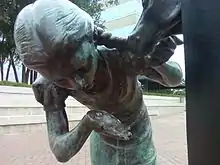
The Asheville Community Theatre was founded in 1946, producing the first amateur production of the Appalachian drama Dark of the Moon.[70] Soon after, the young actors Charlton Heston and wife Lydia Clarke took over the small theatre.[71] The current ACT building has two performance spaces – the Mainstage Auditorium (and named the Heston Auditorium); and the more intimate black box performance space 35below.[72]
The Asheville Lyric Opera celebrated its 10th anniversary in 2009 with a concert featuring Angela Brown, David Malis, and Tonio Di Paolo, veterans of the Metropolitan Opera.[73] The ALO has typically performed three fully staged professional operas for the community in addition to its vibrant educational program.
The Fringe Arts Festival features alternative performances.[74]
Visual arts
- Flood Fine Arts Center, a non-profit contemporary art institution formerly in the River Arts District and now in nearby Black Mountain.
- Asheville Art Museum, located on Pack Square in downtown Asheville, which reopened on November 14, 2019 after a $24 million renovation.[75]
- Black Mountain College Museum + Arts Center, located on Pack Square in downtown Asheville, which presents exhibitions, performances and other public programs related to the history and influence of Black Mountain College.
- The Southern Highland Craft Guild's Folk Art Center, dedicated to Appalachian craft traditions.[76]
- The YMI Cultural Center, exhibiting art related to the heritage of African Americans in the area.[77]
Film and television
The Asheville Film Festival has completed its sixth year, but the City of Asheville ceased to fund it, putting its future in doubt. The city is an annual participant in the 48-Hour Film Project.[78]
The Twin Rivers Media Festival is an independent multi-media film festival held annually in downtown Asheville.[79][80] The festival held its 20th annual event in May 2013.[81]
Places of worship
Places of worship in Asheville include the Roman Catholic Basilica of St. Lawrence, the Episcopal Cathedral of All Souls and St. Luke's Church, and the Jewish Congregation Beth Israel.
Restaurants
Asheville was the first U.S. city recognized by the Green Restaurant Association as a Green Dining Destination (significant density of green restaurants).[82]
Local notable restaurants include Plant, an upscale vegan restaurant, and Tupelo Honey Cafe.
Points of interest
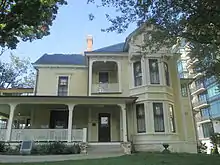
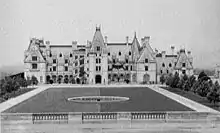
- The Arras, tallest structure in Asheville
- Biltmore Estate, largest privately owned house in the United States, and listed as U.S. National Historic Landmark
- Blue Ridge Parkway, a national parkway noted for its scenic beauty, known as "America's Favorite Drive"
- Botanical Gardens at Asheville, non-profit botanical gardens initially designed by Doan Ogden
- Demens-Rumbough-Crawley House, "Hanger Hall", built by Peter A. Demens, listed on the National Register of Historic Places
- Grove Park Inn, hotel listed on U.S. National Register of Historic Places
- Jackson Building, first skyscraper in western North Carolina
- McCormick Field, one of the oldest minor-league stadiums still in regular use
- North Carolina Arboretum, arboretum and botanical garden located within the Bent Creek Experimental Forest
- Smith-McDowell House, the city's first mansion and oldest surviving house, and the oldest brick structure in Buncombe County
- Thomas Wolfe House, boyhood home of American author Thomas Wolfe, and a U.S. National Historic Landmark
Sports
Current teams
| Club | Sport | Founded | League | Venue |
|---|---|---|---|---|
| Asheville Tourists | Baseball | 1897 | South Atlantic League | McCormick Field |
| Asheville City SC | Soccer | 2016 | USL League Two | Memorial Stadium |
| Asheville City SC (Women's Team) | Soccer | 2017 | Women's Premier Soccer League | Memorial Stadium |
Previous teams
| Club | Sport | Founded | League | Venue | Years in Asheville |
|---|---|---|---|---|---|
| Asheville Smoke | Ice Hockey | 1991 | United Hockey League | Asheville Civic Center | 1998-2002 |
| Asheville Aces | Ice Hockey | 2004 | Southern Professional Hockey League | Asheville Civic Center | 2004-2005 |
| Asheville Altitude | Basketball | 2001 | National Basketball Developmental League | Asheville Civic Center | 2001-2005 |
Other sports
Area colleges and universities, such as the University of North Carolina at Asheville, compete in sports. UNCA's sports teams are known as the Bulldogs and play in the Big South Conference. The Fighting Owls of Warren Wilson College participate in mountain biking and ultimate sports teams. The college is also home of the Hooter Dome, where the Owls play their home basketball games. The Blue Ridge Rollergirls, Asheville's first Women's Flat-Track Roller Derby team was established in 2006. [83]
Parks and recreation
Asheville is a major hub of whitewater recreation, particularly whitewater kayaking, in the eastern US. Many kayak manufacturers have their bases of operation in the Asheville area.[84] Some of the most distinguished whitewater kayakers live in or around Asheville.[85] In its July/August 2006 journal, the group American Whitewater named Asheville one of the top five US whitewater cities.[85] Asheville is also home to numerous Disc Golf courses. Soccer is another popular recreational sport in Asheville. There are two youth soccer clubs in Asheville, Asheville Shield Football Club and HFC. The Asheville Hockey League provides opportunities for youth and adult inline hockey at an outdoor rink at Carrier Park. The rink is open to the public and pick-up hockey is also available. The Asheville Civic Center has held recreational ice hockey leagues in the past.
Government
Local government
The City of Asheville operates under a council-manager form of government, via its charter. The city council appoints a city manager, a city attorney, and a city clerk.[86] In the absence or disability of the mayor, the vice-mayor performs the mayoral duties. The vice-mayor is appointed by the members of City Council. City Council determines the needs to be addressed and the degree of service to be provided by the administrative branch of city government.
In 2005 Mayor Charles Worley signed the U.S. Conference of Mayors Climate Protection Agreement and in 2006 the City Council created the Sustainable Advisory Committee on Energy and the Environment. In 2007 the Council became the first city on the East Coast to commit to building all municipal buildings to LEED Gold Standards and to achieve 80 percent energy reduction of 2001 standards by 2040. Also in 2007 the Council signed an agreement with Warren Wilson College stating the intent of the city and college to work together toward climate partnership goals.
Current City Council Members
- Mayor: Esther Manheimer
- Vice-Mayor: Gwen Wisler
- Council: S. Antanette Mosley [87]
- Council: Brian Haynes
- Council: Julie Mayfield
- Council: Sheneika Smith
- Council: Keith Young
Controversy
In 2009, a group of Asheville citizens challenged the legitimacy of Cecil Bothwell's election to the City Council,[88] citing the Constitution of North Carolina, which does not permit atheists to hold public office.[89] Bothwell has described himself as a "post theist" rather than an atheist[90] and is a member of a local Unitarian Universalist congregation. The opponents to his election never filed suit. In response to the charge, legal scholars explained that the U.S. Supreme Court held in Torcaso v. Watkins that religious tests for political office are unconstitutional.[91]
Bothwell served his four-year Council term and was re-elected in 2013.[92] He was defeated in the primary when he ran for a third term in 2017.[93]
While the city council elections are non-partisan, party politics may enter into play, as Republican and Democratic party members back their registered members' candidacy. An effort by the council to return to partisan elections was defeated by voters in a referendum held in November 2007.
State government
In the North Carolina Senate, Terry Van Duyn (D-Asheville) and Chuck Edwards (R-Hendersonville) both represent parts of Buncombe County. Van Duyn represents most of the city of Asheville. Edwards represents a small portion of the southern part of Asheville.[94]
In the North Carolina House of Representatives, Susan Fisher (D-Asheville), John Ager (D-Asheville), and Brian Turner (D-Asheville) all represent parts of the county.[95] All three of them represent parts of the city, although the majority of it is in Fisher's district.
Federal government
In the 2012 presidential election, Barack Obama won the entirety of Buncombe County with 55% of the vote. Obama visited the city on a few occasions.[96] In April 2010, he and his family vacationed in the city; it was the first time he visited since October 5, 2008.[97]
In the United States presidential election of 2016, Hillary Clinton won 54% of the vote in Buncombe County and Donald Trump 40%, according to the North Carolina State Board of Elections.
North Carolina is represented in the United States Senate by Richard Burr (R-Winston-Salem) and Thom Tillis (R-Greensboro). The city of Asheville is located in North Carolina's 11th congressional district, which is currently represented by Madison Cawthorn (R-Hendersonville).
Education
.jpg.webp)
Students (K-12) are assigned to one of two public school systems in the city of Asheville, Buncombe County Schools or Asheville City Schools, based on address.
Public Asheville City Schools include Asheville High School (known as Lee H Edwards High School 1935–1969), School of Inquiry and Life Sciences at Asheville, Asheville Middle School, Claxton Elementary, Randolph Learning Center, Hall Fletcher Elementary, Isaac Dickson Elementary, Ira B. Jones Elementary and Vance Elementary. Asheville High has been ranked by Newsweek magazine as one of the top 100 high schools in the United States.
The Buncombe County Schools System operates high schools, middle schools and elementary schools both inside and outside the city of Asheville. North Buncombe High School, T. C. Roberson High School and A. C. Reynolds High School are three Buncombe County schools located in Asheville.[98]
Asheville was formerly home to one of the few Sudbury schools in the Southeast, Katuah Sudbury School. It is also home to several charter schools, including Francine Delany New School for Children (one of the first charter schools in North Carolina), ArtSpace Charter School, Invest Collegiate Imagine, and Evergreen Community Charter School, an Outward Bound-Expeditionary Learning School, recognized as one of the most environmentally conscious schools in the country.[99]
Two private residential high schools are located in the Asheville area: the all-male Christ School (located in Arden) and the co-educational Asheville School. Other private schools include Carolina Day School, Veritas Christian Academy, Asheville Catholic School,[100] and Asheville Christian Academy.
Colleges
Asheville and its surrounding area have several institutions of higher education:
- Asheville-Buncombe Technical Community College (Asheville)
- Black Mountain College (Black Mountain: 1933–1957)
- Shaw University College of Adult and Professional Education or C.A.P.E.
- Brevard College (Brevard)
- Lenoir-Rhyne University - Center for Graduate Studies of Asheville (Asheville)
- Mars Hill University (Mars Hill)
- Montreat College (Montreat)
- University of North Carolina at Asheville (Asheville)
- Warren Wilson College (Swannanoa)
- Western Carolina University (Cullowhee)
- Blue Ridge Community College (Flat Rock)
- South College - Asheville (Asheville)
Media
Asheville is in the "Greenville-Spartanburg-Asheville-Anderson" television DMA and the "Asheville" radio ADI for the city's radio stations.[101]
The primary television station in Asheville is ABC affiliate WLOS-TV Channel 13, with studios in Biltmore Park and a transmitter on Mount Pisgah. Other stations licensed to Asheville include WUNF, a PBS (UNC-TV) station on Channel 33 and The CW affiliate WYCW on Channel 62. Asheville is also served by the Upstate South Carolina stations of WYFF Channel 4 (NBC), WSPA-TV Channel 7 (CBS), WHNS-TV Channel 21 (FOX), MyNetworkTV station WMYA Channel 40 and 3ABN station Channel 41. SCETV PBS affiliates from the Upstate of South Carolina are generally not carried on cable systems in the North Carolina portion of the DMA, though are accessible via an HD antennae in some areas.
The Asheville Citizen-Times is Asheville's daily newspaper which covers most of Western North Carolina. The Mountain Xpress is the largest weekly in the area, covering arts and politics in the region. The Asheville Daily Planet is a monthly paper.
The Biltmore Beacon is a weekly newspaper specifically written to be of interest to residents and businesses in the various Biltmore communities including Biltmore Forest, Biltmore Park, Biltmore Lake, and Biltmore Village.
WCQS: Blue Ridge Public Radio is Asheville's public radio station. It has National Public Radio news and other programs, classical and jazz music. WYQS (BPR News) is the sister station to WCQS, offering local news and NPR programming.
Friends of Community Radio created WSFM-LP, a volunteer-based, grassroots community radio station. The station is licensed under the "Free Form" format. There are also a variety of broadcasts dedicated to Poetry, Interviews, Selected Topics, Children's Radio, and Comedy. The staff have remote broadcast many local concerts including (but not limited to) Monotonix from Israel, JEFF the Brotherhood from Nashville, Screaming Females from New Jersey, and local acts.
Infrastructure
Transportation
Asheville is served by Asheville Regional Airport in nearby Fletcher, North Carolina,[102] and by Interstate 40 (east-west),[103]:I-40 Interstate 240 (north loop from I-40),[104]:I-240 and Interstate 26 (north-south).[103]:I-26 Additional major roadways providing access to Asheville include U.S. routes 19 and 74, and North Carolina state routes 191 and 280.[105] Passenger rail service is not available for the city. The city operates Asheville Rides Transit (ART), which consists of sixteen bus lines,[106] providing service throughout the City of Asheville and to Black Mountain, North Carolina.
A milestone was achieved in 2003 when Interstate 26 was extended nine miles from Mars Hill (north of Asheville) to Johnson City, Tennessee, completing a seven-year ¼-billion dollar construction project,[107] part of a twenty-year ½-billion dollar construction project through the Blue Ridge Mountains. Work continues to improve Interstate 26 from Mars Hill to Interstate 40 by improving U.S. Route 19 and U.S. Route 23 and the western part of Interstate 240. This construction will include a multimillion-dollar bridge to cross the French Broad River.[108]
The Norfolk Southern Railway passes through the city, but passenger service is no longer available in the area. The city was last served until 1970 by the Southern Railway's Asheville Special (New York-Washington-Asheville, ended, 1970). Before that, it was served by the Southern's Skyland Special (Asheville-Columbia-Jacksonville, ended, 1959) and Carolina Special (Cincinnati-Goldsboro and Charleston branches, ended, 1968).
In 2020, the city received a $US1 million grant from the Federal Transit Administration to be used primarily on the ART bus transit system.[109]
Public services and utilities
The residents of Asheville are served by the Buncombe County Public Libraries, consisting of 11 branches located throughout the county; the headquarters and central library, Pack Memorial Library, is located in downtown Asheville.[110] The system includes a law library in the Buncombe County Courthouse and a genealogy and local history department located in the central library.
Drinking water in Asheville is provided by the Asheville water department. The water system consists of three water treatment plants, more than 1,600 miles (2,600 km) of water lines, 30 pumping stations and 27 storage reservoirs.[111]
Sewer services are provided by the Metropolitan Sewerage District of Buncombe County, power provided by Duke Energy, and natural gas is provided by PSNC Energy.
Asheville offers public transit through the ART (Asheville Rides Transit) bus service that operates across the city and to the town of Black Mountain. Routes originate from a central station located at 49 Coxe Avenue.[112]
Notable people
In popular culture
- Author Thomas Wolfe (d. 1938) was born and grew up here, writing about the city; he and O. Henry (d.1910) are buried in Riverside Cemetery. [113]
- Other authors with Asheville ties include Charles Frazier (Cold Mountain), Chicago poet Carl Sandburg (d.1967 in his home in Flat Rock),[114] and F. Scott Fitzgerald (who wrote while staying at the Grove Park Inn).
- Thomas Wolfe's debut novel Look Homeward, Angel (1929) is set largely in Asheville and features a protagonist recognizably similar to the author; the town is named Altamont in the book.
- The character Harrison Shepherd, the narrator and protagonist of Barbara Kingsolver's novel The Lacuna, lived in Asheville.[115]
- Asheville is featured as a location in the novel One Second After by William R. Forstchen (an area resident).[116]
- In the novel Joshua Spassky by British author Gwendoline Riley, the character Natalie visits this city to meet the eponymous hero.
- Deborah Smith's novel The Crossroads Cafe is set in the mountains above Asheville, and prominent scenes take place in the city. Sequels to that novel are also set in this area.
- The Hunger Games was filmed near Asheville.[117]
- James Dashner's dystopian novel The Kill Order (2012) takes place in and around Asheville.
- The film Three Billboards Outside Ebbing Missouri was shot in the Asheville area. The North Carolina tourism board has developed a guide for visitors interested in sites used in the film.[118]
In film
Additional films made at least partially in the area include A Breed Apart, Searching for Angela Shelton, Last of the Mohicans, Being There, My Fellow Americans, Loggerheads, The Fugitive (#1 film), All the Real Girls, Richie Rich, Thunder Road, Hannibal, Songcatcher, Patch Adams, Nell, Forrest Gump, Mr. Destiny, Dirty Dancing, Bull Durham, The Private Eyes, The Swan, The Clearing, The Conquest of Canaan, House of Poets, The Purple Box, and 28 Days.
Locally produced films include Golden Throats of the 20th century and Anywhere, U.S.A.[119], which won a Special Jury Prize for Spirit of Independence at the 2008 Sundance Film Festival. Asheville hosted the ActionFest Film Festival 2010–2012. The 2010 inaugural event honored actor Chuck Norris as the first ActionFest "man of action."
Sustainability and environmental initiatives
The city of Asheville is home to a Duke Energy Progress coal power plant near Lake Julian. This power plant is designated as having Coal Combustion Residue Surface Impoundments with a High Hazard Potential by the EPA.[120] In 2012 a Duke University study found high levels of arsenic and other toxins in North Carolina lakes and rivers downstream from the Asheville power plants coal ash ponds. Samples collected from coal ash waste flowing from the ponds at the Duke Energy Progress plant to the French Broad River in Buncombe County contained arsenic levels more than four times higher than the EPA drinking water standard, and levels of selenium 17 times higher than the agency's standard for aquatic life.[121] In March 2013 the State of North Carolina sued Duke Energy Progress in order to address similar environmental compliance issues. In July 2013 Duke Energy Corp. and North Carolina environmental regulators proposed a settlement in the lawsuit that stated coal ash threatened Asheville's water supply. The settlement called for Duke to assess the sources and extent of contamination at the Riverbend power plant in Asheville. Duke was to be fined $99,100.[122] However, following the coal ash spill in Eden, NC, the North Carolina DENR cancelled all previous settlements with Duke Energy.[123]
The city of Asheville claims a clear focus on sustainability and the development of a green economy. For Asheville, this goal is defined in their Sustainability Management Plan as: "Making decisions that balance the values of environmental stewardship, social responsibility and economic vitality to meet our present needs without compromising the ability of future generations to meet their needs."[124] As part of the Zero Waste AVL initiative, which began in 2012, each resident receives "Big Blue," a rolling cart in which they can put all of their materials unsorted. Residents can recycle a great variety of materials and "in this first year of the program 6.30% of waste was diverted from the landfill for recycling."[125]
The Asheville City Council's goal is to reduce the overall carbon footprint 80% by the year 2030. This means 4% or more reduction per year.[126] In 2009 the reduction was made when the "City installed over 3,000 LED street lights, managed its water system under ISO 14001 standards for environmental management, improved the infrastructure and management of many of its buildings, and switched many employees to a 4-day work week (which saves emissions from commuting)."[124] Asheville is recognized by the Green Restaurant Association as the first city in the U.S. to be a Green Dining Destination (significant density of green restaurants).[82]
Sister cities
Asheville's sister cities are:[127]
 Birnam, Scotland, United Kingdom
Birnam, Scotland, United Kingdom Dunkeld, Scotland, United Kingdom
Dunkeld, Scotland, United Kingdom Karpenisi, Greece
Karpenisi, Greece Osogbo, Nigeria
Osogbo, Nigeria San Cristóbal de las Casas, Mexico
San Cristóbal de las Casas, Mexico Saumur, France
Saumur, France Valladolid, Mexico
Valladolid, Mexico Vladikavkaz, Russia
Vladikavkaz, Russia
Notes
- The record number of annual 90 °F or 32.2 °C readings is 32 in 1952, which would be lower than average in most cities in the southeast U.S.[47]
- Mean monthly maxima and minima (i.e. the expected highest and lowest temperature readings at any point during the year or given month) calculated based on data at said location from 1981 to 2010.
- Official precipitation records for Asheville were kept at Aston Park from March 1869 to July 1876, various locations in the city from August 1876 to August 1964, and at Asheville Regional Airport since September 1964. Snow and temperature records began December 18, 1869 and November 1, 1876, respectively. For more information, see ThreadEx.
References
- "Why Work for BCS?". BCS website. Buncombe County Schools. Archived from the original on September 28, 2016. Retrieved November 3, 2011.
- "2019 U.S. Gazetteer Files". United States Census Bureau. Archived from the original on October 10, 2020. Retrieved July 27, 2020.
- "Quick Facts, Asheville, North Carolina". United States Census Bureau. Archived from the original on November 20, 2020. Retrieved October 1, 2017.
- "Population and Housing Unit Estimates". United States Census Bureau. May 24, 2020. Archived from the original on July 26, 2019. Retrieved May 27, 2020.
- "U.S. Census website". United States Census Bureau. Archived from the original on December 27, 1996. Retrieved January 31, 2008.
- "GNIS Feature Search". United States Geological Survey. June 17, 1980. Archived from the original on November 20, 2020. Retrieved January 6, 2015.
- "NACo County Explorer". National Association of Counties. March 30, 2020. Retrieved 26 December 2020.
- "Annual Estimates of the Resident Population for Incorporated Places in North Carolina: April 1, 2010 to July 1, 2019". City and Town Population Totals: 2010-2019 (Excel (XLSX)). United States Census Bureau. May 13, 2020. Asheville city, North Carolina. Retrieved December 28, 2020.
- "Annual Estimates of the Resident Population for Metropolitan Statistical Areas in the United States and Puerto Rico: April 1, 2010 to July 1, 2019". March 20, 2020.
- "Original extent of Cherokee claims 1732" (map/.GIF). Collection at the University of Georgia. June 26, 1996. Archived from the original on June 26, 2006. Retrieved July 23, 2006.
- The Historic News (1999). "A History of Asheville and Buncombe County". Old Buncombe County Genealogical Society. Archived from the original (text/.html) on June 19, 2006. Retrieved July 23, 2006.
- Neufeld, Rob (July 29, 2018). "Visiting Our Past: Asheville before Asheville: Cherokee girls, De Soto's crimes". Asheville Citizen-Times. Archived from the original on November 20, 2020. Retrieved July 29, 2018.
- "Cherokee History, Part One" (text/.html). Lee Sultzman. February 28, 1996. Archived from the original on July 7, 2006. Retrieved July 23, 2006.
- "Asheville – 0–1800 The Early Settlers". Asheville.be. 2006. Archived from the original (text/.html) on July 21, 2006. Retrieved July 23, 2006.
- Neal, Dale. "Cherokee reclaim landmarks of ancient Asheville". www.citizen-times.com. Archived from the original on November 20, 2020. Retrieved September 28, 2020.
- url=http://www.history.swannanoavalleymuseum.org/samuel-davidson-first-european-settler-west-of-the-blue-ridge/ Archived June 14, 2018, at the Wayback Machine, November 2016.
- Whisnant, David (August 29, 2015). "Retrospective I: A Primer on the Sad Truths of Slavery in Asheville, Buncombe County and Western North Carolina". Asheville Junction: A Blog by David Whisnant.
- Alex S. Caton; Rebecca Lamb (1999–2004). "The Early Settlement of Buncombe Country and the Drover's Road". Smith-McDowell House Museum. Archived from the original (text/.html) on July 20, 2006. Retrieved July 23, 2006.
-
various (2001–2002). "Asheville". Western North Carolina Heritage. Land of the Sky. Archived from the original on May 1, 2006. Retrieved July 23, 2006.
In his [Samuel Ashe] honor the name of Morristown was changed to Asheville.
CS1 maint: uses authors parameter (link) - Hartley, Stoneman's Raid, p. 362 (Blair, 2010)
- Hartley, supra, at p. 350-358.
- "NC Business History - Railroad - Western North Carolina Railroad history & officers". Historync.org. Archived from the original on October 30, 2013. Retrieved June 29, 2013.
- NEUFELD, ROB (September 22, 2019). "Visiting Our Past: Asheville promotions gained steam before the railroad". Citizen Times. Archived from the original on November 20, 2020. Retrieved September 23, 2019.
- The Federal Writers' Project of the Federal Works Agency, Works Projects Administration for the State of North Carolina, North Carolina: A Guide to the Old North State, The University of North Carolina Press, Chapel Hill, 1939, page 139.
- Jeffrey, Thomas E. (1998). Thomas Lanier Clingman. google.com. ISBN 9780820320236. Archived from the original on November 20, 2020. Retrieved October 15, 2020.
- "Appalachian History: Manuscript Resources in Special Collections". Special Collections. University Libraries, Virginia Tech. May 2, 2005. Asheville and Spartanburg Railroad Company. Archived from the original on January 6, 2015. Retrieved January 6, 2015.
- The Federal Writers' Project of the Federal Works Agency, Works Projects Administration for the State of North Carolina, "North Carolina: A Guide to the Old North State", ISBN 0403021820; The University of North Carolina Press, Chapel Hill, 1939, pages 69, 139.
- "North Carolina Cities Population Changes in the 1800s". North Carolina Business History. Archived from the original on June 30, 2017. Retrieved July 5, 2017.
- "Black History Month: Edward R. Pearson". Citizen Times. Retrieved March 6, 2019.
- Neufeld, Rob (July 2, 2017). "Visiting Our Past: President's son helped create West Asheville". Asheville Citizen-Times. Archived from the original on November 20, 2020. Retrieved July 4, 2017.
- Hunt, Max. "Passage to the past: Inside the bowels of the Asheville Masonic Temple". Mountain Xpress. Archived from the original on July 10, 2019. Retrieved July 10, 2019.
- "8 CAROLINA BANKS FAIL AS BOOM ENDS". The New York Times. November 21, 1930. Archived from the original on February 26, 2018. Retrieved April 25, 2010.
- "Preservation-Asheville, North Carolina: A National Register of Historic Places Travel Itinerary". Nps.gov. Archived from the original on November 5, 2012. Retrieved June 29, 2013.
- Boyle, John (February 6, 2015). "Did Asheville pay off its Depression-era debt?". Asheville Citizen-Times. p. A2.
- "ABOUT". D. H. Ramsey Library Special Collections. University of North Carolina at Asheville. Archived from the original on May 16, 2008.
- "Preservation--Asheville, North Carolina: A National Register of Historic Places Travel Itinerary". www.nps.gov. Archived from the original on February 2, 2017. Retrieved November 28, 2016.
- Santora, Marc (September 20, 2004). "Storm's Devastation Is Revealed, and a Mountain Hamlet Mourns". The New York Times. Archived from the original on November 20, 2020. Retrieved February 5, 2017.
- Postelle, Brian (November 10, 2004). "Sleeping giant | Mountain Xpress |". Mountainx.com. Archived from the original on June 17, 2011. Retrieved June 29, 2013.
- "Red lines |". Archived from the original on July 16, 2020. Retrieved March 23, 2020.
- Neal, Dale. "Hood tours revisit Asheville's black landmarks". The Asheville Citizen Times. Archived from the original on November 20, 2020. Retrieved March 23, 2020.
- Ellingwood, Ken (June 2, 2003). "The Nation; Fugitive's Capture Heightens Speculation; Locals are touchy about the theory that some sympathetic with his anti-government views helped the suspected bomber elude the law". Archived from the original on March 15, 2013. Retrieved August 22, 2017.
- Fletcher, Michael A (June 3, 2003). "Rudolph to be tried first in Alabama; Abortion clinic bomb case said to be strongest". Chicago Tribune. Archived from the original on March 15, 2013. Retrieved August 22, 2017.
- Burgess, Joel (July 15, 2020). "In Historic Move, North Carolina City Approves Reparations for Black Residents". USA Today. Archived from the original on July 15, 2020. Retrieved July 15, 2020.
- Boyle, John (August 2, 2020). "What to do with the Vance obelisk?". Asheville Citizen-Times. Archived from the original on November 20, 2020. Retrieved August 3, 2020.
- Wicker, Mackenzie (July 14, 2020). "Confederate monument removed from Buncombe Courthouse property". Asheville Citizen-Times. Archived from the original on November 20, 2020. Retrieved August 3, 2020.
- "USDA Plant Hardiness Zone Map". planthardiness.ars.usda.gov. Archived from the original on February 27, 2014. Retrieved November 28, 2016.
- "NowData - NOAA Online Weather Data". National Oceanic and Atmospheric Administration. Archived from the original on November 16, 2018. Retrieved October 3, 2019.
- "NOAA records for August – Asheville, NC". noaa.gov. Archived from the original on December 27, 2004. Retrieved November 12, 2007.
- "Fletcher, NC Weather History | Weather Underground". www.wunderground.com. Archived from the original on January 7, 2019. Retrieved January 7, 2019.
- "Station Name: NC ASHEVILLE RGNL AP". National Oceanic and Atmospheric Administration. Archived from the original on July 25, 2020. Retrieved September 4, 2016.
- "WMO Climate Normals for ASHEVILLE/REGIONAL, NC 1961–1990". National Oceanic and Atmospheric Administration. Archived from the original on July 25, 2020. Retrieved September 4, 2016.
- "Asheville Neighborhoods". Ashevilleneighborhoods.info. March 20, 2010. Archived from the original on April 4, 2016. Retrieved May 22, 2016.
- Chase, Nan K. Asheville: A History, (2007): p.39, 61, 93.
- "S&W Cafeteria". Asheville's Built Environment. University of North Carolina at Asheville. Archived from the original on December 28, 2007.
- "Homepage". The Urban News. Archived from the original on October 28, 2020. Retrieved October 29, 2020.
- "Archived copy". Archived from the original on May 20, 2007. Retrieved May 12, 2007.CS1 maint: archived copy as title (link)
- "Census Bureau Home Page". Census.gov. Archived from the original on December 27, 1996. Retrieved May 22, 2016.
- "Population Estimates". United States Census Bureau. Archived from the original on March 28, 2019. Retrieved June 8, 2018.
- METROPOLITAN STATISTICAL AREAS AND COMPONENTS Archived May 26, 2007, at the Wayback Machine, Office of Management and Budget, May 11, 2007. Accessed 2008-08-01.
- MICROPOLITAN STATISTICAL AREAS AND COMPONENTS Archived June 29, 2007, at the Wayback Machine, Office of Management and Budget, May 11, 2007. Accessed 2008-08-01.
- COMBINED STATISTICAL AREAS AND COMPONENT CORE BASED STATISTICAL AREAS Archived June 29, 2007, at the Wayback Machine, Office of Management and Budget, May 11, 2007. Accessed 2008-08-01.
- "Pilgrimage - Jubilee Year of Mercy". Basilica of Saint Lawrence. Archived from the original on September 4, 2017. Retrieved November 28, 2018.
- "City of Asheville Comprehensive Annual Financial Report" (PDF). Ashevillec.gov. Archived from the original (PDF) on April 1, 2017. Retrieved May 22, 2016.
- "Music pumps up economy, enlivens nightlife"; Michael Flynn; Asheville Citizen-Times; August 22, 2003
- Dewan, Shaila (October 24, 2010). "36 Hours in Asheville". The New York Times. Retrieved June 6, 2011.
- "Amped Up". WNC Magazine. April 11, 2019. Archived from the original on February 22, 2020. Retrieved February 22, 2020.
- "Music star Warren Haynes gives back to community - CNN.com". edition.cnn.com. Archived from the original on August 10, 2020. Retrieved October 23, 2020.
- "Archived copy". Archived from the original on September 27, 2007. Retrieved June 23, 2007.CS1 maint: archived copy as title (link)
- "The Kingsmen". New Haven Records. Archived from the original on October 29, 2020. Retrieved October 23, 2020.
- "Asheville Community Theatre » PRODUCTION HISTORY". Ashevilletheatre.org. Archived from the original on January 28, 2016. Retrieved January 22, 2016.
- "Asheville Community Theatre". Ashevilleguidebook.com. Archived from the original on September 12, 2015. Retrieved January 22, 2016.
- "Asheville Community Theatre | Asheville, NC's Official Travel Site". Explore Asheville. Archived from the original on January 29, 2016. Retrieved January 22, 2016.
- "The Asheville Fringe Arts Festival - Asheville Fringe Arts Festival". Asheville Fringe Arts Festival. Archived from the original on December 30, 2012. Retrieved January 26, 2013.
- "Asheville Art Museum re-opens after major three-year expansion project". Art Daily. Jose Villareal. Archived from the original on December 20, 2019. Retrieved December 2, 2019.
- "Folk Center". Southern Highland Craft Guild. Archived from the original on February 17, 2020. Retrieved February 14, 2020.
- "YMI Cultural Center – Blue Ridge National Heritage Area". Archived from the original on February 22, 2020. Retrieved February 22, 2020.
- "48-Hour Film Festival Asheville". 48hourfilm.com. Archived from the original on November 10, 2016. Retrieved May 22, 2016.
- staff (May 18, 2012). "Asheville's River Arts District hosts 19th annual Twin Rivers Media Festival beginning Friday" (PDF). ashevillenc.gov. Retrieved August 13, 2015.
- Moe, Jack. "The Vision of the Twin Rivers Media Festival-Asheville, NC". Appalachian Getaways. Archived from the original on August 10, 2015. Retrieved August 13, 2015.
- Motsinger, Carol (May 9, 2013). "20th annual Twin Rivers Media Festival opens May 17". Asheville Citizen-Times. Retrieved August 13, 2015.
- "Archived copy". Archived from the original on December 1, 2013. Retrieved August 9, 2013.CS1 maint: archived copy as title (link)
- "Blue Ridge Rollergirls". WFTDA. Archived from the original on October 26, 2020. Retrieved October 23, 2020.
- "Rocking the boat". Mountain Xpress. Archived from the original on September 27, 2007. Retrieved June 23, 2007.
- American Whitewater Journal July/August 2006 (not published on the web yet)
- "About City Government". Ashevillenc.gov. Archived from the original on August 1, 2013. Retrieved June 29, 2013.
- Bush, Matt. "Antanette Mosley Appointed To Asheville City Council". www.bpr.org. Archived from the original on September 25, 2020. Retrieved September 29, 2020.
- Jordan Schrader; Dale Neal (December 8, 2009). "Critics of Cecil Bothwell cite N.C. bar to atheists". Asheville Citizen-Times. Archived from the original on August 7, 2011. Retrieved December 10, 2009.
- "Article VI: Suffrage and Eligibility to Office - Sec. 8. Disqualifications for office". North Carolina State Constitution. State of North Carolina. Archived from the original on February 9, 2014. Retrieved February 15, 2014.
The following persons shall be disqualified for office: First, any person who shall deny the being of Almighty God.
- "Critics of Cecil Bothwell cite N.C. bar to atheists". The Asheville Citizen-Times. Archived from the original on January 10, 2013. Retrieved April 13, 2013.
- "Asheville councilman atheism debate goes viral: Cecil Bothwell gets wide audience". citizen-times.com.
- "Wisler, Smith, Bothwell win council seats". Asheville Citizens-Times. November 5, 2013. Retrieved February 15, 2014.
- Bowman, Joel Burgess, Mark Barrett, Alexandria Bordas and Jennifer. "Kapoor, Manheimer dominate Asheville primary; Bothwell loses". The Asheville Citizen Times. Archived from the original on November 20, 2020. Retrieved April 29, 2018.
- "United States - North Carolina - NC State Senate - NC State Senate 48". Our Campaigns. May 10, 2007. Archived from the original on January 8, 2014. Retrieved June 29, 2013.
- NC General Assembly webmasters. "North Carolina General Assembly - Buncombe County Representation (2013-2014 Session)". Ncleg.net. Archived from the original on June 2, 2013. Retrieved June 29, 2013.
- James, Frank (October 17, 2011). "Obama Hearts North Carolina But It May Have Lost That Loving Feeling : It's All Politics". NPR. Archived from the original on August 13, 2013. Retrieved June 29, 2013.
- Wing, Nicholas (April 16, 2010). "Obama Vacation: First Family To Visit Asheville, North Carolina". Huffington Post. Archived from the original on March 20, 2012. Retrieved October 25, 2011.
- "Schools Directory". www.buncombeschools.org. Archived from the original on October 31, 2020. Retrieved October 23, 2020.
- "Evergreen Community Charter School, Asheville North Carolina - Evergreen Community Charter School, Asheville North Carolina". Evergreenccs.org. Archived from the original on July 6, 2013. Retrieved June 29, 2013.
- "Asheville Catholic School". Archived from the original on June 16, 2020. Retrieved June 16, 2020.
- "Market Ranks". arbitron.com. Archived from the original on August 1, 2007. Retrieved September 2, 2007.
- FAA5010_1 (Airport Master Record) (PDF) (Report). U.S. Department of Transportation, Federal Aviation Admininistration. December 3, 2020. AVL (Local ID). Retrieved December 28, 2020.
- "Table 1 - Main Routes - FHWA Route Log and Finder List - Interstate Highway System - National Highway System - Planning - FHWA". National Highway System. U.S. Department of Transportation, Federal Highway Administration. December 31, 2018. Retrieved December 28, 2020.
- "Table 2 - Auxiliary Routes - FHWA Route Log and Finder List - Interstate Highway System - National Highway System - Planning - FHWA". National Highway System. U.S. Department of Transportation, Federal Highway Administration. December 31, 2018. Retrieved December 28, 2020.
- "Asheville, NC" (PDF). National Highway System (Map). U.S. Department of Transportation, Federal Highway Administration. October 1, 2020. Retrieved December 30, 2020.
- "Maps & Schedules". ashevillenc.gov. Archived from the original on March 6, 2014. Retrieved March 6, 2014.
- "Interstate 26". Asheville Citizen-Times. 134 (215) (Final ed.). Asheville, North Carolina: Gannett. August 3, 2003. p. A5. Retrieved December 28, 2020 – via Newspapers.com.
- "I-26 Connector, Asheville, NC". Public Information Website. North Carolina Department of Transportation. n.d. Archived from the original on July 6, 2006. Retrieved August 20, 2006.
- Whitehead, Brittany (October 15, 2020). "Asheville Rides Transit bus system to undergo $1.25m in upgrades". MSN. Retrieved December 30, 2020.
- "Libraries - Branch Locations". Buncombe County. Archived from the original on March 29, 2016. Retrieved March 28, 2016.
- "Water Production". City of Asheville, NC. Archived from the original on March 23, 2016. Retrieved March 28, 2016.
- "Asheville Transit". City of Asheville. Archived from the original on March 31, 2016. Retrieved March 28, 2016.
- "Riverside Cemetery". cityofasheville.github.io. Archived from the original on January 30, 2018. Retrieved January 30, 2018.
- "Frequently Asked Questions - Carl Sandburg Home National Historic Site (U.S. National Park Service)". www.nps.gov. Archived from the original on November 20, 2020. Retrieved January 30, 2018.
- "About The Lacuna | Barbara Kingsolver". www.kingsolver.com. Archived from the original on January 30, 2018. Retrieved January 30, 2018.
- "Apocalypse WNC". Mountain Xpress. Archived from the original on January 30, 2018. Retrieved January 30, 2018.
- "Visit the North Carolina Locations Where 'The Hunger Games' Was Filmed". ABC News. July 16, 2015. Archived from the original on July 19, 2018. Retrieved July 19, 2018.
- "Explore Authentic Locations From 'Three Billboards Outside Ebbing,…". VisitNC.com. Archived from the original on February 23, 2018. Retrieved February 23, 2018.
- "Anywhere USA Sundance Award". History.sundance.org. Archived from the original on March 4, 2016. Retrieved May 22, 2016.
- "Coal Combustion Residuals (CCR) - Surface Impoundments with High Hazard Potential Ratings". Archived from the original on December 3, 2013. Retrieved November 29, 2013.
- "Duke University: Progress Energy plant polluting French Broad River, October 15, 2012". Archived from the original on November 29, 2013.
- "NC files new lawsuits against Duke Energy today, August 16, 2013". Archived from the original on November 29, 2013.
- "Local News - The Asheville Citizen-Times - citizen-times.com". The Asheville Citizen-Times.
- "Sustainability Management Plan" (PDF). Ashevillenc.gov. August 2009. Archived from the original (PDF) on March 4, 2016. Retrieved May 22, 2016.
- "Sustainability". Ashevillenc.gov. Archived from the original on May 20, 2016. Retrieved May 22, 2016.
- "City of Asheville Carbon Footprint Annual Report : 2011-2012" (PDF). Ashevillenc.gov. Archived from the original (PDF) on March 4, 2016. Retrieved May 22, 2016.
- "Our Sister Cities". Asheville Sister Cities Inc. Archived from the original on October 28, 2020. Retrieved October 25, 2020.
Bibliography
- "Buncombe County". Branson's North Carolina Business Directory (6th ed.). Raleigh: Levi Branson. 1884. Archived from the original on March 12, 2017. Retrieved August 25, 2017.
- Asheville City Directory. Southern Directory Co. 1887.
- Lindsey's Guide Book to Western North Carolina. Asheville: T.H. Lindsey. 1890. Archived from the original on March 12, 2017. Retrieved August 25, 2017.
- Asheville and Vicinity, a Handbook of Information, Containing an Exhaustive History of Asheville. Atlanta: J.D. Eggleston and J.S. McIlwaine. 1897. Archived from the original on March 12, 2017. Retrieved August 25, 2017.
- Foster A. Sondley (February 1898), "Asheville's Centenary", Asheville Citizen
- F.H. Richardson (1905). "Asheville, N.C.". Richardson's Southern Guide. Chicago: Monarch Book Company – via Internet Archive.
- "Asheville", United States (4th ed.), Leipzig: K. Baedeker, 1909, OCLC 02338437
- Chisholm, Hugh (1910), "Asheville", Encyclopædia Britannica (11th ed.), New York, OCLC 14782424, archived from the original on March 12, 2017, retrieved August 25, 2017
- John Preston Arthur (1914). "County History: Buncombe County". Western North Carolina: a History (from 1730 to 1913). Raleigh: Edwards & Broughton. pp. 143–159. Archived from the original on March 12, 2017. Retrieved August 25, 2017. (Includes information about Asheville)
- "Everybody Helps: Asheville's Unique Method of Raising Money". Town Development: A Magazine for the Man Who Believes in Himself and in His Town. New York. 13. December 1914. OCLC 52158201. Archived from the original on March 12, 2017. Retrieved August 25, 2017.
- Asheville, North Carolina City Directory, Commercial Service Co., 1921
- F.A. Sondley; Theodore Davidson (1922). Asheville and Buncombe County. Asheville: The Citizen Co.
- "Asheville Builds a New City". American City Magazine. New York: Civic Press. 35. September 1926. OCLC 29653835. Archived from the original on March 12, 2017. Retrieved August 25, 2017.
- Federal Writers' Project (1939). "Asheville". North Carolina: a Guide to the Old North State. American Guide Series. Chapel Hill: University of North Carolina Press. p. 137+.
- City of Asheville (2003), Asheville 2025 Plan, archived from the original on August 25, 2017, retrieved August 25, 2017
- Paul T. Hellmann (2006). "North Carolina: Asheville". Historical Gazetteer of the United States. Taylor & Francis. ISBN 1-135-94859-3. Archived from the original on August 18, 2018. Retrieved August 25, 2017.
- Chase, Nan K. 2007. Asheville, a history. Jefferson, NC: McFarland & Co.
- Lisa Gregory (2010), "Asheville", in William S. Powell (ed.), Encyclopedia of North Carolina, University of North Carolina Press, archived from the original on August 14, 2017, retrieved August 25, 2017
- William S. Powell; Michael Hill (2010). "Asheville". North Carolina Gazetteer (2nd ed.). University of North Carolina Press. ISBN 978-0-8078-9829-1. Archived from the original on March 12, 2017. Retrieved August 25, 2017.
External links
| Wikimedia Commons has media related to Asheville, North Carolina. |
- Official Asheville, NC website
- Asheville, North Carolina, a National Park Service Discover Our Shared Heritage Travel Itinerary
- Asheville travel guide by Asheville Convention and Visitors Bureau
 Asheville travel guide from Wikivoyage
Asheville travel guide from Wikivoyage- "North Carolina Room". Asheville: Pack Memorial Library.
Collecting and preserving the history of Asheville, Buncombe County, and western North Carolina
- Items related to Asheville, North Carolina, various dates (via Digital Public Library of America)
- Ramsey Library. "Appalachian Studies". Research Guides. Asheville: University of North Carolina. (Subject guide)
- Humanities and Social Sciences Division. "Resources for Local History and Genealogy by State: North Carolina". Bibliographies and Guides. Washington DC: Library of Congress.

